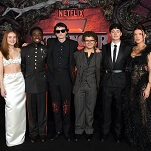Yoshi's Woolly World, Badges and a Forgotten History of Cheating

This year my resolution is to cheat more. When it comes to videogames, anyway. I came to this conclusion while playing Yoshi’s Woolly World in bed. I’m enamored with its crafted look, and the game is both lighthearted and challenging. But what earned my affection was the all little ways that Yoshi’s Wooly World lets you break the game. As with its predecessor, Kirby’s Epic Yarn, beads can be collected throughout each level. Epic Yarn used them to gauge the player’s completion of the stage. Woolly World does this too, however it also lets you trade them in for Badges, which act as expendable powerups. Crucially, the player can use them both at the start of the level, but within it as well. No more eggs? Bring in infinite watermelons to spit machine gun seeds at your target. Keep falling in lava? Switch on immunity to fire and bounce off the lava to grab secrets with ease. You can also switch to Mellow Mode at any time, slowing down the enemies and giving you wings that let you float indefinitely. It’s all entirely optional, but it lets you break the game in wonderful ways and turns each stage into a little sandbox. It reminds me of the way I used to play games as a kid.
Before the rise of online connected consoles, it was common to find cheat devices in retail stores. GameSharks and Game Genies allowed the player to read a game’s memory values and modify them using specific codes. It could act as a makeshift level select, let you continue indefinitely, or grant the power of invisibility. Sometimes you’d get a code resulting in the useless and bizarre, like changing Yoshi’s color to black or white in Super Mario World. Cheats would often also be built into the games themselves, and books that sold these secret combinations of game breaking button sequences were in high demand. There was a certain pride in knowing these codes, and my friends and I would impress each other by trading our passed-along knowledge.
There was a certain social acceptance to cheating. In some games, cheating was the way to play the game. What are the early Grand Theft Auto games without a city-wide rampage fueled by an illegitimately earned arsenal of high powered weapons and flying cars? Likewise, my memory of Sonic the Hedgehog 2 will always be tied to the codes entered at the sound test screen. These cheats would let you jump between levels, or get all the Chaos Emeralds and see Super Sonic, a feat no one I knew could do legitimately. And of course there’s the Konami Code, made famous by its inclusion in Contra, a demanding NES run and gun shooter. For games like these, cheat codes gave you a way to see parts of game you might not otherwise never see.
The inclusion of cheats began to slow down as games switched to optical media. Data from CDs and DVDs couldn’t be rewritten, and cheat devices only had memory card save data left to manipulate. While some games continued to include cheat codes, the expanded scope of games meant that developers often hid these game breaking methods as unlockable content instead.
Cheat codes finally became irrelevant when the HD era began. The popularity of online multiplayer meant cheating became associated with behavior that gave players unfair advantages that spoiled the game for others. The addition of persistent online profiles also brought about Achievements, digital badges given for reaching certain milestones or completing optional objectives. While they had no material benefit, they became a way to measure yourself against others. That little bit of status meant that completing a game was no longer a personal achievement, but a public one. And for those badges to mean anything you’d need to know others had to put in the same effort to get them. So cheats either required achievements to be disabled, or removed entirely.
At the same there’s been a desire to push for “player-centric” designs. Open world games like Skyrim, Assassin’s Creed, and Metal Gear Solid V present clockworld environments that offer complex interactions, but never seem to function without the player’s presence. So while the idea of player freedom has become a huge selling point, the alternative methods of play that cheats enabled have been phased out. That’s not to say that games need to let you ascend to godhood in order to offer true player choice. Rather, there’s a pull between the ways games try to offer freedom within the rules of the game, while losing the ability to play outside of those rules, or make up your own.
In LIARS CHEATERS AND THIEVES, Kate R posits that a lot of the current resistance to cheating lies in its image as a destructive act. It takes the rules and systems of a game and removes the possibility of failure, and the challenge of it. She explains that not only is this a very narrow idea of cheating, as outside information can also give you a huge advantage, but ignores the new modes of play and interaction enabled by cheating. It also assumes an ideal image of a game that’s not to be tampered with, and dismisses modifications made for convenience or accessibility. But even avoiding parts of the game doesn’t mean you’re not engaging with it. In her words:











































